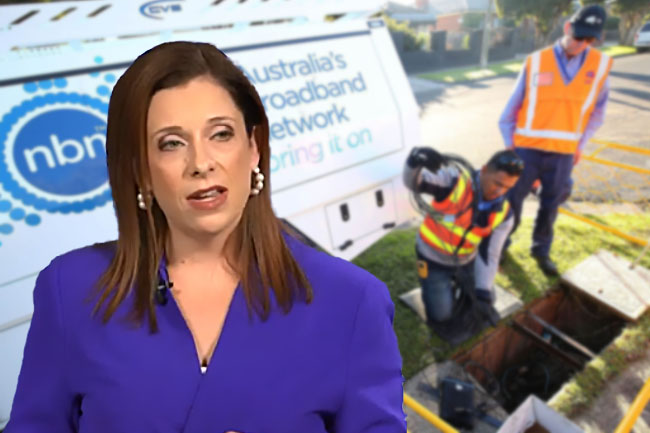A call for the resignation of the NBN Board goes to the heart of the NBN issue. Why did we build the NBN? What was the original vision? And why was the government willing to invest?
At the time this was seen as a national asset.
The call for the NBN Board's resignation was made by Commpete, the former Competitive Carriers Coalition. Obviously, its particular disappointment with the NBN relates to the fact that the NBN has failed to deliver the promised pro-competition outcomes, and that is a valid point. But to understand the situation we must dig deeper into the original vision and development of the NBN.
We need to go back to the decade leading up to the start of the NBN — now some 15 to 20 years ago. The government, supported by consumers and businesses, indicated that a high-speed broadband network was essential infrastructure for any modern society.
Having established support, the question was how to best build such infrastructure. In the first instance, they looked at the market, and both Australian and international telecoms engineers indicated that the ultimate infrastructure for high-speed broadband would have to be fibre-based.
Of course, the new developments in mobile technologies were taken into account. All experts agreed that fibre was the most cost-effective long-term solution for large-scale mass-market broadband. This meant that both the copper cable networks and the HFC networks would have to be replaced by fibre.
That being the case, the question arose as to whether competition would deliver such an outcome. The reality is that it doesn’t make any kind of economic sense to have multiple national fibre optic networks competing with each other. The only viable economic outcome was a national fibre network. In order to maintain a competitive environment, such a network would have to be built on a wholesale basis, with competition taking place on the top of that on a service basis. A fibre network would create the basis for a large range of new services beyond the traditional telecoms services. This would include e-business, entertainment, e-government, healthcare, education, home automation and so on.
By the end of that decade (around 2009), the basic consensus among government, industry and consumers was that a national FTTH network was the way to go. Yes, it was expensive in its upfront costs, but it would save ongoing maintenance costs and set the country up for the future. Most people agreed that such a project is done only once, so it must be done well.
So the plan in 2009 was to build an FTTH network that would cover 94 per cent of the population. The network would be based on a wholesale-only basis with full open competition at the retail level. This was how the NBN was started and rolled out over the next four years.
When the new Coalition Government arrived in 2013, it moved the technology away from FTTH. What happened next was that the whole business model began to unravel. The costs of building the multi-technology mix infrastructure (MTM) proceeded to double from the estimate of $25 billion (according to the then Minister for Communications, Malcolm Turnbull) to the current $50 billion.
As the technology now became second-rate the business opportunities for new retail services diminished. Gone were the technological advantages that come with the high capacity that fibre offered, so wholesale prices now also became relatively high for the low quality of services that could be provided over the MTM infrastructure.
In order to cover the high investment costs of MTM, the prices consumers would have to pay for this second-rate network would be at the level of a top-notch FttH service. As a consequence, the wholesale/retail model started to unravel as well. The ACCC has concluded that in some instances consumers now pay more for a lower quality NBN service than they did for their previous ADSL service.
This poor quality makes it difficult for retail providers to demand higher retail prices. As a result, their margins are becoming unsustainable, especially for the entry-level NBN products.
All of this has a negative effect on retail service providers and as such it has a negative effect on competition.
Returning to the original argument from Commpete on whether the NBN Board has delivered on the original promises of providing an innovative competitive environment? Based on the above analysis the answer, to a large extent, must be no. The Board can argue that they had to follow political instructions, but in the end, they should have been independent enough to warn that the MTM infrastructure would be unable to deliver the outcomes that were promised under the original plan in 2009.
Over the last decade, I have mentioned on many occasions that I was disappointed at the failure of the NBN organisation to allude to the inability of the Coalition Government's MTM policy to deliver the outcomes of an FTTH infrastructure. That same criticism can be made in relation to the Board.
We are now stuck with a second-rate network (62nd in global rankings) and a faltering competitive environment, as well as with a serious financial debacle for NBN Co, which needs to recoup its expensive investment. It will be interesting to hear what the NBN Board has to say about that when a review takes place after the 2019 Federal Election.
Paul Budde is managing director of Paul Budde Communication, an independent telecommunications research and consultancy organisation. You can follow Paul on Twitter @PaulBudde.
 This work is licensed under a Creative Commons Attribution-NonCommercial-NoDerivs 3.0 Australia License
This work is licensed under a Creative Commons Attribution-NonCommercial-NoDerivs 3.0 Australia License
Support independent journalism Subscribe to IA.












